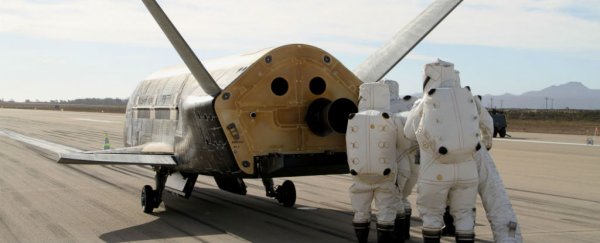On 20 May 2015, the US military launched the robotic X-37B space plane into Earth's orbit to carry out its fourth top secret mission.
Now, more than 500 days later, that solar-powered, unmanned drone is still up there, and with no word on how long it will remain in orbit - or what it's actually doing up there - it's spurring the same kinds of conspiracy theories that followed it through its previous missions.
Is it deploying spy satellites into Earth's atmosphere? Is it interfering with the signals of other satellites? Is it part of the Pentagon's research into drone-based weaponry, or has it been keeping tabs on China's ill-fated space station this whole time?
Your guess is as good as mine, but what we do know is that during its 500 days in obit, it's been carrying several payloads - a few of which have actually been identified.
It's ferried a couple of prototype electric propulsion devices from the Air Force and private aerospace and defence company Aerojet Rocketdyne, plus it's got collateral from NASA's advanced materials investigation on board, which aims to test how the space environment affects certain materials.
"It remains a very useful way to test out things," said Winston Beauchamp, deputy undersecretary of the Air Force for Space, during last month's American Institute of Aeronautics and Astronautics (AIAA) meeting in California.
The Air Force's first such mission - called the OTV-4 mission (or Orbital Test Vehicle-4) - launched in April 2010, and almost immediately, the public was suspicious.
Things only got worse when several amateur observers reported that space plane flies over the same region on the ground every four days.
"In interviews and statements, Pentagon leaders strongly denied that the winged plane had anything to do with space weapons, even while conceding that its ultimate goal was to aid terrestrial war fighters with a variety of ancillary missions," the New York Times reported in May 2010.
The Air Force responded vaguely by stating that the secret mission has "no offensive capabilities," but rather, "The program supports technology risk reduction, experimentation, and operational concept development."
The second OTV-4 mission began on 5 March 2011, and spent 468 days in orbit. The third mission saw X-37B spend nearly 675 days in orbit, and this current mission could see it spend even longer up there.
Even if we never find out what X-37B's mission actually is, at least it's showcasing the capabilities of prolonged solar-powered flight.
The Air Force states that the first three OTV-4 missions spent a total of 1,367 days in orbit, and successfully demonstrated its reusable flight, reentry, and landing technologies. And let's face it, if there's something we desperately need for exploring the surfaces of other planets, it's solid automated landing techniques.
And hey, if it really is spying on China's out-of-control Tiangong-2 space lab, maybe it can tell us where bits of it might land after it burns up in the atmosphere.
The truth is out there?
H/T Space.com
